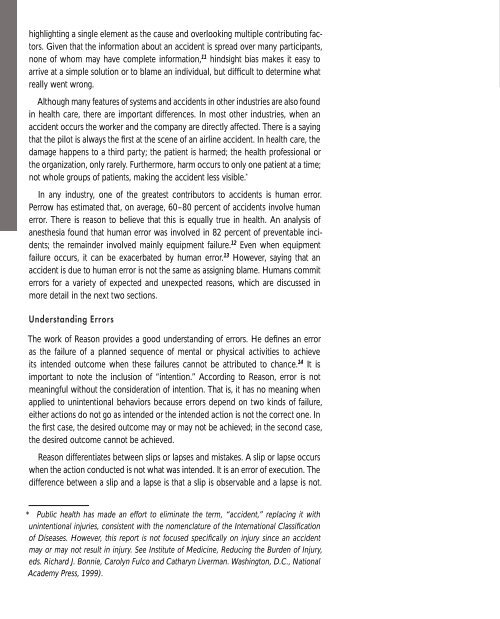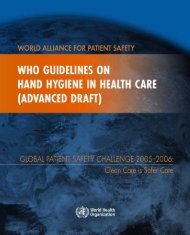Adverse event reporting.pdf
Adverse event reporting.pdf
Adverse event reporting.pdf
You also want an ePaper? Increase the reach of your titles
YUMPU automatically turns print PDFs into web optimized ePapers that Google loves.
highlighting a single element as the cause and overlooking multiple contributing factors.<br />
Given that the information about an accident is spread over many participants,<br />
none of whom may have complete information, 11 hindsight bias makes it easy to<br />
arrive at a simple solution or to blame an individual, but difficult to determine what<br />
really went wrong.<br />
Although many features of systems and accidents in other industries are also found<br />
in health care, there are important differences. In most other industries, when an<br />
accident occurs the worker and the company are directly affected. There is a saying<br />
that the pilot is always the first at the scene of an airline accident. In health care, the<br />
damage happens to a third party; the patient is harmed; the health professional or<br />
the organization, only rarely. Furthermore, harm occurs to only one patient at a time;<br />
not whole groups of patients, making the accident less visible. *<br />
In any industry, one of the greatest contributors to accidents is human error.<br />
Perrow has estimated that, on average, 60–80 percent of accidents involve human<br />
error. There is reason to believe that this is equally true in health. An analysis of<br />
anesthesia found that human error was involved in 82 percent of pr<strong>event</strong>able incidents;<br />
the remainder involved mainly equipment failure. 12 Even when equipment<br />
failure occurs, it can be exacerbated by human error. 13 However, saying that an<br />
accident is due to human error is not the same as assigning blame. Humans commit<br />
errors for a variety of expected and unexpected reasons, which are discussed in<br />
more detail in the next two sections.<br />
Understanding Errors<br />
The work of Reason provides a good understanding of errors. He defines an error<br />
as the failure of a planned sequence of mental or physical activities to achieve<br />
its intended outcome when these failures cannot be attributed to chance. 14 It is<br />
important to note the inclusion of “intention.” According to Reason, error is not<br />
meaningful without the consideration of intention. That is, it has no meaning when<br />
applied to unintentional behaviors because errors depend on two kinds of failure,<br />
either actions do not go as intended or the intended action is not the correct one. In<br />
the first case, the desired outcome may or may not be achieved; in the second case,<br />
the desired outcome cannot be achieved.<br />
Reason differentiates between slips or lapses and mistakes. A slip or lapse occurs<br />
when the action conducted is not what was intended. It is an error of execution. The<br />
difference between a slip and a lapse is that a slip is observable and a lapse is not.<br />
* Public health has made an effort to eliminate the term, “accident,” replacing it with<br />
unintentional injuries, consistent with the nomenclature of the International Classification<br />
of Diseases. However, this report is not focused specifically on injury since an accident<br />
may or may not result in injury. See Institute of Medicine, Reducing the Burden of Injury,<br />
eds. Richard J. Bonnie, Carolyn Fulco and Catharyn Liverman. Washington, D.C., National<br />
Academy Press, 1999).
















